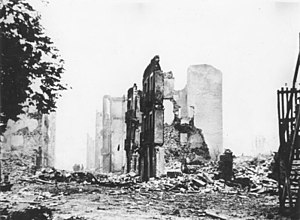Chemical Bombing of Kawingyi: Difference between revisions
BattlerNonna (talk | contribs) m (→Consequences) |
BattlerNonna (talk | contribs) m (→Consequences) |
||
| Line 40: | Line 40: | ||
==Consequences== | ==Consequences== | ||
===Bloody Highway=== | |||
{{main|Bloody Highway}} | |||
Throughout the [[Free Bethausian Army]], the chemical bombing triggered a massive outrage among troops. Soon, during the [[Invasion of Quenmin]], this vehement anger culminated in a series of retaliatory {{wp|mass murders}} and {{wp|pogroms}} committed by the Bethausian troops, nicknamed [[Bloody Highway]]. It became the most controversial act committed by the Allies during the conflict, garnering significant backlash among Allied commanders and heads-of-state. | Throughout the [[Free Bethausian Army]], the chemical bombing triggered a massive outrage among troops. Soon, during the [[Invasion of Quenmin]], this vehement anger culminated in a series of retaliatory {{wp|mass murders}} and {{wp|pogroms}} committed by the Bethausian troops, nicknamed [[Bloody Highway]]. It became the most controversial act committed by the Allies during the conflict, garnering significant backlash among Allied commanders and heads-of-state. | ||
Revision as of 06:28, 7 October 2019
| Chemical Bombing of Kawingyi | |
|---|---|
| Part of the Second Europan War | |
 Remains of Kawingyi | |
| Type | Aerial bombing |
| Location | |
| Planned by | Marshal Count Thach Hung Son Chien and Imperial Marshal Bernard Gregor |
| Date | 21 July 1943 10:00 – 13:00 |
| Executed by | |
| Outcome | Destruction of Kawingyi. Uninhabitable for 20 years. |
| Casualties | All 50,000 civilians killed |
The Chemical Bombing of Kawingyi (21 July 1943) was an aerial bombing that took place in the Bethausian city of Kawingyi. It was carried out by Marshal Count Thach Hung Son Chien and Imperial Marshal Bernard Gregor in order to test the effects of Brynyl, which was a more deadly derivative of the Imperial chemical Sarin. The results exceeded their expectations and proceeded to move to the second part of their plan, which was Operation B-1, the plan to wipe out Lucis Commonwealth cities off the map.
The bombing became the most controversial move in the war because it involved the bombing of civilians by a military air force. It is also seen as one of the most notorious Imperial war crimes ever committed. The population of the city of Kawingyi were eradicated and the city would prove to be uninhabitable for the next 20 years. During the Cao Khoat Trials of 1945, all those implicated and involved in the bombing were executed without trial.
The bombing shocked the Allies and never knew that the Imperials would do something as inhumane as the bombing. The bombing was uncovered in mid-1944, prompting the Lucis Commonwealth to drop an Atomic bomb on the Imperial city of Albern and the Quenminese city of Haigia in late-June 1945, finally forcing the Imperials to surrender unconditionally.
Background
The Bombing
Effects
Consequences
Bloody Highway
Throughout the Free Bethausian Army, the chemical bombing triggered a massive outrage among troops. Soon, during the Invasion of Quenmin, this vehement anger culminated in a series of retaliatory mass murders and pogroms committed by the Bethausian troops, nicknamed Bloody Highway. It became the most controversial act committed by the Allies during the conflict, garnering significant backlash among Allied commanders and heads-of-state.